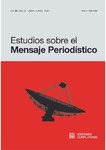Mostrar o rexistro simple do ítem
Preferencias televisivas de la audiencia española (2005-2019): programas, formatos y cadenas
| dc.contributor.author | González-Neira, Ana | |
| dc.contributor.author | Quintas-Froufe, Natalia | |
| dc.date.accessioned | 2020-05-25T09:24:47Z | |
| dc.date.available | 2020-05-25T09:24:47Z | |
| dc.date.issued | 2020 | |
| dc.identifier.citation | González-Neira, Ana y Quintas-Froufe, Natalia (2020): “Preferencias televisivas de la audiencia española (2005-2019): programas, formatos y cadenas”. Estudios sobre el Mensaje Periodístico 26 (2), 583-595. | es_ES |
| dc.identifier.issn | 1988-2696 | |
| dc.identifier.uri | http://hdl.handle.net/2183/25626 | |
| dc.description.abstract | [Resumen] En los últimos quince años el sector audiovisual español ha sufrido grandes transformaciones derivadas del nacimiento de nuevos canales generalistas como Cuatro (2005) y La Sexta (2006), el apagón analógico y el fin de la publicidad en RTVE (2010) o la llegada de nuevos agentes emisores como Netflix (2105), que marcaron su desarrollo. El objetivo de este artículo es conocer si ha habido evolución en las preferencias televisivas de los españoles durante el periodo 2005-2019 en un contexto de redefinición de la televisión como el actual. Las conclusiones indican que existe un desgaste de ciertos formatos como las series de ficción, se mantienen con éxito algunos programas históricos de la televisión en España y se incorporan algunos formatos fruto de la hibridación de géneros. Asimismo se constata un evidente incremento del éxito de contenidos conectados con el presente, anclados al momento actual y cuyo consumo en diferido les merma valor. | es_ES |
| dc.description.abstract | [Abstract] In the last fifteen years the Spanish audiovisual sector has undergone transformations (the analog blackout and the end of advertising on RTVE (2010), the birth of new generalist channels such as Cuatro (2005) and La Sexta (2006) or the arrival of new broadcasting agents such as Netflix (2105) that marked its development. The aim of this paper is to know if there has been evolution in the Spanish television preferences during the 2005-2019 period. The conclusions indicate that there is a wear of some formats such as series, some historical television programs in Spain are successfully maintained and some formats are incorporated as a result of the hybridization of genres. It is also found that there is an evident increase in the success of content connected with the present, anchored to the current moment and whose time shifted consumption diminishes their value. | es_ES |
| dc.language.iso | spa | es_ES |
| dc.publisher | Universidad Complutense de Madrid | es_ES |
| dc.relation.uri | http://dx.doi.org/10.5209/esmp.67777 | es_ES |
| dc.rights | Atribución 3.0 España | es_ES |
| dc.rights.uri | http://creativecommons.org/licenses/by/3.0/es/ | * |
| dc.subject | Televisión | es_ES |
| dc.subject | Audiencia | es_ES |
| dc.subject | Formatos | es_ES |
| dc.subject | Programas | es_ES |
| dc.subject | Prime time | es_ES |
| dc.subject | Audimetría | es_ES |
| dc.subject | Television | es_ES |
| dc.subject | Audience | es_ES |
| dc.subject | Formats | es_ES |
| dc.subject | Programs | es_ES |
| dc.subject | Prime time | es_ES |
| dc.subject | Audimetry | es_ES |
| dc.title | Preferencias televisivas de la audiencia española (2005-2019): programas, formatos y cadenas | es_ES |
| dc.title.alternative | Television preferences of the Spanish audience (2005-2019): programs, formats and channels | es_ES |
| dc.type | info:eu-repo/semantics/article | es_ES |
| dc.rights.access | info:eu-repo/semantics/openAccess | es_ES |
| UDC.journalTitle | Estudios sobre el Mensaje Periodístico | es_ES |
| UDC.volume | 26 | es_ES |
| UDC.issue | 2 | es_ES |
| UDC.startPage | 583 | es_ES |
| UDC.endPage | 595 | es_ES |
Ficheiros no ítem
Este ítem aparece na(s) seguinte(s) colección(s)
-
II - Artigos [442]






